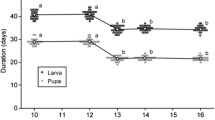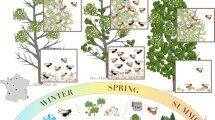Abstract
The two-spotted spider mite, Tetranychus-urticae is one of the most damaging polyphagous pests in India. The life history of mated and unmated females of T. urticae was studied on five important host plants namely, Justicia-adhatoda L. (Malabar nut), Wissadula-periplocifolia (L.) Thwaites-(white velvet leaf),-Citrus limon (L.) Osbeck (lemon), Mangifera indica L. (mango) and Syzygium jambolanum (Lam.) DC (water apple), under controlled laboratory conditions at 25 ± 5 °C, 65 ± 5% relative humidity (RH) and photoperiod of 12:12 (L:D). Results revealed no significant variation in life history traits of mated and unmated females of T. urticae on the tested host plants. In contrast only the fecundity and hatchability of mated and unmated females were proved different on different host plants. We, therefore, infer that all the tested host plants provide suitable resource for successful completion of life history of T. urticae. Interestingly, we recorded highest daily and total fecundity rate on M. indica and that suggests preference of two spotted spider mite for mango over other tested host pant. Overall, we can infer that T. urticae can be considered as potential polyphagous pest which could pose serious threat to different crops, fruits and vegetables on which they thrive successfully.







Similar content being viewed by others
References
Atalay E, Kumral NA (2013) Biological features and life tables of Tetranychus urticae (Koch) (Acari: Tetranycidae) on different table tomato varieties. Türk Entomol Derg-Tu 37:329–341
Bruessow A, Asins F, Jacas MJ, Urbaneja JA (2010) Replacement of CTV-susceptible sour orange rootstock by CTV-tolerant ones may have triggered outbreaks of Tetranychus urticae in Spanish citrus. Agric Ecosyst Environ 137:93–98. https://doi.org/10.1016/j.agee.2010.01.005
Golizadeh A, Ghavidel S, Razmjou J, Fathi SAA, Hassanpour M (2017) Comparative life table analysis of Tetranychus urticae Koch (Acari: Tetranychidae) on ten rose cultivars. Acarologia 57:607–616. https://doi.org/10.24349/acarologia/20174176
Gotoh T, Nagata T (2001) Development and reproduction of Oligonychus coffeae (Acari: Tetranychidae) on tea. Int J Acarol 27:293–298. https://doi.org/10.1080/01647950108684269
Kasap I (2002) Biology and life tables of the two-spotted spider mite, Tetranychus urticae (Acari: Tetanychidae) on three different host plants in laboratory conditions. Türk Entomol Derg-Tu 26:257–266
Kumral NA, Goksel PH, Aysan E, Kolcu A (2017) Biological parameters and population development of Tetranychus urticae Koch, 1836 (Acari: Tetranychidae) on different pepper cultivars. Türk Entomol Derg-Tu 41:263–273. https://doi.org/10.16970/entoted.297132
Kumral NA, Goksel PH, Aysan E, Kolcu A (2019) Life table of Tetranychus urticae Koch (Acari: Tetranycidae) on different Turkish eggplant cultivars under controlled conditions. Acarologia 59:12–20. https://doi.org/10.24349/acarologia/20194307
Migeon A, Dorkeld F (2019) Spider Mites Web: a comprehensive database for the Tetranychidae http://www.montpellier.inra.fr/CBGP/spmweb. Accessed 14 Sept 2019
Migeon A, Tixier M-S, Navajas M, Litskas VD, Stavrinides MC (2019) A predator-prey system: Phytoseiulus persimilis (Acari: Phytoseiidae) and Tetranychus urticae (Acari: Tetranychidae): worldwide occurrence datasets. Acarologia 59:301–307. https://doi.org/10.24349/acarologia/20194322
Monteiro LB, Kuhn TMA, Mogor AF, Silva EDB (2014) Biology of the two-spotted spider mite on strawberry plants. Neotrop Entomol 43:183–188. https://doi.org/10.1007/s13744-013-0184-7
Najafabadi SSM, Shoushtari RV, Zamani AA, Arbabi M, Farazmand H (2014) Life parameters of Tetranychus urticae (Acari: Tetranychidae) on six common bean cultivars. J Econ Entomol 107:614–622. https://doi.org/10.1603/EC11205
Praslicka J, Huszar J (2004) Influence of temperature and host plants on the development and fecundity of the spider mite Tetranychus urticae (Acarina: Tetranychidae). Plant Protect Sci 40:141–144
Razmjou J, Tavakkoli H, Fallahi A (2009) Effect of soybean cultivar on life history parameters of Tetranychus urticae Koch (Acari: Tetranychidae). J Pest Sci 82:89–94. https://doi.org/10.1007/s10340-008-0227-8
Razmjou J, Tavakkoli H, Nemati M (2009) Life history traits of Tetranychus urticae on three legumes (Acari: Tetanychidae). Munis Entomol Zool 4:204–211
Riahi E, Nemati AR, Shishehbor P, Saeidi Z (2011) Population growth parameters of the two-spotted spider mite, Tetranychus urticae, on three peach varieties in Iran. Acarologia 51:473–480. https://doi.org/10.1051/acarologia/20112029
Riahi E, Shishehbor P, Nemati AR, Saeidi Z (2013) Temperature effects on development and life table parameters of Tetranychus urticae (Acari: Tetranychidae). J Agric Sci Technol 15:661–672
Sedaratian A, Fathipour Y, Moharramipour S (2011) Comparative life table analysis of Tetranychus urticae (Acari: Tetranychidae) on 14 soybean genotypes. J Insect Sci 18:541–553. https://doi.org/10.1111/j.1744-7917.2010.01379.x
Sheela K, Ramani N (2012) Phytophagous mites - a potential threat to medicinal plants in Kerala, India. Int J Acarol 38:62–65. https://doi.org/10.1080/01647954.2011.577453
Vacante V (2016) The handbook of mites of economic plants. CABI Publisher, Wallingford, p 872
Wahed NM, Halawany AS (2012) Effect of temperature degrees on the biology and life table parameters of Tetranychus urticae Koch on two pear varieties. Egypt Acad J Biol Sci 4:103–109. https://doi.org/10.21608/eajbsz.2012.13876
Zhang ZQ (ed) (2003) Mites of greenhouses: Identification, biology and control. CABI, Wallingford
Acknowledgements
We extend our sincere gratitude to the Director, Zoological Survey of India, Kolkata for his assistance. We are also thankful to Dr. Tridip Kumar Dutta, ENVIS Centre, Zoological Survey of India, Kolkata for his help in statistical analysis. We would like to thank the reviewers for their helpful comments and continuous corrections to improve our manuscript.
Funding
The work has been funded by “Fund for Improvement of Science and Technology” of the Department of Science and Technology, Government of India (DST-FIST).
Author information
Authors and Affiliations
Corresponding author
Ethics declarations
Conflict of Interest
The authors declare that they have no conflict of interest.
Grants
The work has been supported by University Grants Commission under Universities with Potential for Excellence scheme (UGC/UPE-II facilities).
Rights and permissions
About this article
Cite this article
Mitra, S., Acharya, S. & Ghosh, S. Implication of five host plants on the life history trait of Tetranychus urticae (Acari: Tetranychidae). Biologia 76, 517–524 (2021). https://doi.org/10.2478/s11756-020-00547-2
Received:
Revised:
Accepted:
Published:
Issue Date:
DOI: https://doi.org/10.2478/s11756-020-00547-2




